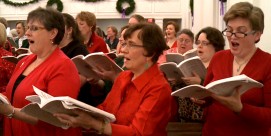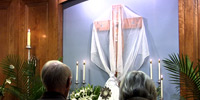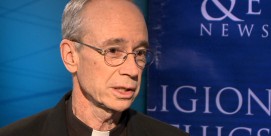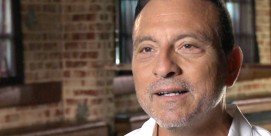In This Episode << SLIDE LEFT TO SEE ADDITIONAL SEGMENTS
Diana Butler Bass Extended Interview
Read more of Kim Lawton’s interview about the emergent church with Diana Butler Bass, author of THE PRACTICING CONGREGATION: IMAGINING A NEW OLD CHURCH (Alban Institute):
What is an emergent church?
An emergent church is a congregation that is trying to speak to a new set of cultural conditions. It’s not any longer assuming that American culture is a Christian culture or a Protestant culture. Instead it’s trying to speak the old truths of the Gospel in new ways that respond to a post-Christian setting.
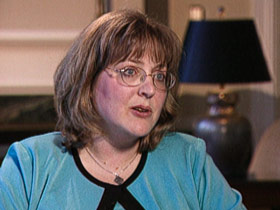
What are the shifting cultural patterns that are posing challenges for congregations?
Once upon a time in America you could assume that people were Christians and not only Christians but you could assume they were Protestant Christians. Almost all the recent studies show that the name “Protestant” doesn’t mean nearly what it used to in previous generations. Fewer people are identifying themselves as Protestants, and that whole cultural package that went along with being Protestant — praying in certain kinds of ways, scripture reading, going to church weekly — that’s all become something of the past. It’s no longer part of the fabric of what people just grow up with any longer in the United States. So there’s been a real shift away from a distinctly Protestant culture, and even in more recent years away from a distinctly Christian context in the United States as we become much more pluralistic. There’s also an increase of people who don’t identify at all with any religious tradition. And so there are people who belong to a lot of different religions and many more people who claim no religious allegiance whatsoever.
Today people are growing up in that kind of setting. There’s no kind of expectation we can have anymore that people speak a particular religious language. For Protestants that’s been a big change, because Protestants used to assume that the culture would simply carry Protestant faith to new generations. It doesn’t do that anymore.
What are some of the characteristics of people growing up in this generation? If they don’t understand the Protestant language, if they’re not getting that from the culture, what are some of their cultural characteristics?
They’re very savvy church shoppers. They’ve been marketed to by consumerist culture all of their lives. I mean, the Gap knows how to market to them, Coca-Cola, any media company knows how to get the allegiance of these folks. And so when they come to a congregation, they don’t essentially want to be marketed to. But they come in the door and they’re looking for something that’s genuine. They’re looking for spiritual practices that will meet their needs and they’re looking for a meaning in their lives. So often I think 20s and 30s say that they feel disconnected from any kind of religious tradition at all, so they want to reconnect and they also want to be able to learn about religion because they don’t have any kind of grounding, typically, in a tradition. They’re kind of rootless, and they’re very savvy. They’re not just looking for you to throw a lot of snazzy programming at them. Instead, they’re looking for real people who are on a real spiritual journey that they can join into and find a way to live their lives with meaning in a very chaotic world.
You’ve been listening in to the emergent conversation. What are some of the needs of this generation that the movement seems to be touching on?
They seem to be hitting the chord about authenticity. I think that a lot of the 20s and 30s who are going into the typical megachurch setting — the kind of Willow Creek-type churches that were set up mostly in the mostly the 1970s and 1980s — some of these younger adults are finding them phony. The Willow Creek-type church structure that was very popular with baby boomers has not really adapted to meet the needs of a much more rootless generation that’s in search of tradition. I think that the programs and the leadership structures of the old megachurch movement just doesn’t seem as authentic spiritually to younger adults in their 20s and 30s. They’re looking for new expressions. They’re looking for different ways in which people gather together.
I’ve been very surprised in recent years. I’ve seen a couple of smaller studies saying that younger American adults prefer to be in middle-sized to even smaller congregations where they can make greater personal connections and can also have a more hands-on contribution in terms of the ministry. I think there’s a shift away from entertainment-oriented, program-based megachurches among younger adults to wanting to be part of a genuine spiritual community where they can learn a tradition, school their children in tradition, as they’re now getting married and having young families, and where they can connect with other people in community who are the same age and who are interested in some of the same things they’re interested in.
There is a change in the structures that they’re expecting out of congregations. [It] doesn’t mean the megachurch is going to disappear. There’s always going to be an audience or a market for that. But it also means a cultural space is opening up for a different kind of congregation, and the emergent congregations appear to be entering into that space and meeting the needs of a different generation of Americans.
You say they’re looking for tradition. In some cases they’re creating their own traditions by borrowing from lots of different traditions.
That is one of the most stunning trends in American religion right now — this return to tradition. Because people didn’t have it they’re needing to go out and look for it, and that means when they find a tradition they’re not usually adopting whatever tradition just because it’s Lutheran or Episcopalian or whatever. They’re going out, and they’re searching for traditions that have meaning. They’re stitching together a variety of traditions to create a complex of traditions in a new congregational setting. They are borrowing. I’ve seen some amazing instances of people with one sort of denominational level reaching way far into Eastern Orthodoxy or some other form of ancient Christianity, medieval mysticism, even to Jewish and Buddhist traditions, and then Christianizing them within the context of their congregations. It’s a very fertile time for traditions blending, but people are typically taking old stuff and remaking it in new ways. Even when they’re creating, they’re creating tradition on their own.
Why is this happening? What do you think underlies this trend?
When people grow up without any tradition, there appears to be almost a psychological or theological or spiritual need in human beings to connect with something that people have done before. I’m sure there are some people in this culture who are perfectly comfortable living a completely contemporary life. But for most of us there’s a need, even on a personal or family level, to be in touch with our grandparents, to understand what life was like in the past. And now with mobility and people not growing up within religious traditions, they have to go out, and they have to find those connections themselves. That’s part of it. Once you de-traditionalize culture — which is a word that socialists particularly in England use to talk about the cultural condition in which the West finds itself — then there’s this open territory in which different kinds of traditions can be birthed. That’s what we’re going through right now, a kind of cultural re-traditioning. We’ve moved away from what we had in the West, particularly in the 18th, 19th and early 20th centuries. All those traditions have been broken, and now we’re in a space where we’re exploring to see what kinds of traditions will carry us into an uncertain future.
Emergent congregations which are newly birthed and see innovation as something at their core — the place where they’re going to be innovative is this area of re-traditioning. Here are a number of people, many of whom grew up in evangelicalism, a tradition that in and of itself is sort of rootless, and now they’re wanting to root in tradition. In the emergent congregations that I’ve visited, and I’ve been in quite a few now, you see them taking traditions out of mainline Protestantism — weekly Eucharist, for example. You see them taking mystical practices out of medieval Roman Catholicism. You see them borrowing all kinds of things. It’s really stunning to see within these post-evangelical, Free Church, nondenominational settings this great grasping or groping for traditional structures in which to reshape congregations. It’s a really interesting development.
But at the same time that they might be borrowing traditional practices, many of them are urging a rethinking of traditional teachings or doctrines. Why is that happening at the same time? What does that say?
In the same way that they’re willing to blend spiritual traditions, they’re also willing to blend theological traditions. You see people from emergent [churches] pulling out of their own evangelical backgrounds, happily reading folks like John Stott or traditional of evangelical theologians, but also reaching into neo-orthodoxy from the middle part of the twentieth century — tremendous influence of Dietrich Bonhoffer and Karl Bart on these folks theologically. But now they’re beginning to be in conversation with mainline theology as well. There’s an interest in people like Walter Brueggemann and Phyllis Tickle, Stanley Hauerwas, Miroslov Volf, and so they’re reading theology that’s being written by people who teach at mainline seminaries. You hear more conversation about that in emergent circles than you do about the theologians writing in evangelical seminaries. I’m sure that has some evangelical seminary professors a little upset. But it’s part of the whole ethos of spiritual blending that very much is part of emergence personality as it is coming to be.
Some are even pushing beyond that, though, urging a real rethinking of traditional Protestant doctrines. How does that reflect the cultural direction?
I haven’t seen any emergent people moving off of centering, classic Christian doctrines. I’m not familiar with anybody who is saying that the Trinity is not a good idea. But what I do see them arguing is that even classical Protestant thought is weak in some places, in this understanding of the Trinity or other central points of Christian theology. They’re willing to reach into Eastern Orthodoxy or Roman Catholicism. You also do see interesting conversation between some of these folks and Jewish scholarship, which I think is unexpected. They’re willing to listen to voices outside the Christian tradition to understand some of the theological riches within the Christian tradition. It’s an interesting moment in terms of people being willing to cross boundaries to think about very old issues within Christian theology.
What have you been finding of these trends within mainline congregations?
One of the big surprises of my research in the last three years was to study mainline churches that are interested in reappropriating tradition and introducing new Christian practices — well, old Christian practices, as it were — into their congregations. As I was studying those, all of a sudden I found these emergent congregations on a parallel track to these mainline churches.
A friend of mine refers to the congregations in my study as re-emergent congregations. What these Protestant congregations are doing is saying we were effectively secularized in the 1960s and 1970s. We were much more interested in cultural questions — being modern or relevant, being cutting edge. We lost our grounding within the larger sense of Christian tradition and spirituality. They’re getting back to basics in that way. They’re going back to Bible study. They’re going back to small groups. They’re going back to centering prayer. And by going back to what was, in a sense, best about themselves four, three, four, five hundred years ago, they’re beginning to find new life. They’re doing a very similar piece of work. But as with the emergent congregations, a Lutheran congregation might not just be borrowing out of Lutheran theology.
As a matter of fact, there’s a congregation in the study, a Lutheran church in southern Virginia, and one of the ways that congregation has grown in the last eight years is by taking Ignatian spirituality and introducing that as a spiritual practice into the life of the whole congregation. Now, that might not seem like very much, but the reality is 500 years ago, St. Ignatius started his movement as a way of stopping the Protestant Reformation and limiting the effect of Lutheranism throughout Europe. So here in southern Virginia 500 years later there are Lutherans finding new life through adopting Ignatian practices. That kind of blending is something we have seen in studying reemergent styles within mainline congregations.
And many of these congregations are becoming more vital and are growing?
The 50 congregations in my study are representative of the mainline. They come from six different denominations. They’re geographically spread. They have male and female pastors. They are theologically centrist to theologically liberal. The churches in the study are growing by several different measures. When we went out to look at these churches, we were not necessarily looking at numerical growth. We were interested more in vitality of spiritual depth, whether or not a congregation was viable, because right now, it’s sad to say, there are thousands of Protestant congregations in this country that are no longer viable. They don’t have enough money to pay their pastors. They don’t have pastors, and they’re barely keeping the doors open. There’s a threshold of viability we were looking at: Is a congregation supporting itself? Can it take care of its needs? Is it reaching outside of itself in order to do mission? We were looking at these kinds of congregations for these benchmarks of vitality and viability. All of our congregations passed that. There is a certain kind of spiritual depth or spiritual vibrancy present in the congregation. It’s obvious when you go in; you can just sense that this is a congregation that’s excited about the future, and it’s a congregation that’s growing and engaged both with the Gospel and with the culture around the church.
We weren’t looking for numbers, and what we found, occasionally, were numbers. Probably 80 percent of the congregations that we have studied have experienced numerical growth, even in places where the demographics cut against mainline Protestants, where the population is moving away from, say, a rural area or where you have more younger people than older people. Even in those areas the congregations are holding their own or growing at some slight level. Most of our congregations have experienced anywhere from a seven to 15 percent per year growth rate.
At Cornerstone United Methodist Church in Naples, Florida — how does that congregation embody some of these new trends?
Most of the congregations I’ve been studying in the mainline are old congregations that are finding new life. In Naples, we have the example of a new congregation that’s part of an old tradition. The congregation is a mission congregation. I believe it started in 1996, and the current pastor is indeed the founding pastor of the church as well. So Naples is a little different. But even in Naples one of the things that is going on is this picking up of old tradition. The new congregation was started around some of the very oldest kinds of practices that Christians have shared. Central to their identity is this idea of the “apostolic core,” a few verses that are found in the Book of Acts about what happens when Christians gather together; they break bread, they pray. And they’ve taken these directives from the Book of Acts, and they made that essentially the congregation’s mission statement. Everyone in Naples can talk about that apostolic core, and they think of the apostolic practices as being central to their lives.
The other thing that Cornerstone has done is gone back to some of the earliest practices of British Methodism in small groups, biblical study, holding one another accountable, the practice of confession, and even, believe it or not, altar calls. It’s really interesting to be in a congregation where every week there’s the possibility of going forward and committing yourself to God in some sort of new way. They have worked that into the Methodist liturgy, and people take it very seriously. They also take public confession as a very serious practice. A brand new church in a growing, dynamic, Sunbelt place where there are lots and lots of new immigrants — they’ve set up their church on some of the oldest and most traditional stuff that Methodist can reach for. It’s all in a very contemporary package. The music is very contemporary, and the setting is, as well, contemporary.
You mentioned a parallel conversation going on among the emergent churches and in the mainline. What are the parallels?
The parallels are this picking up a tradition, blending, returning to the past in order to move forward into the future, a breaking with the business-as-usual models for congregations. The people in the mainline congregations I’m studying are as dissatisfied with their bureaucratic and denominational structures as these emerging evangelicals are with the traditional patterns of setting up evangelical congregations. On both sides of this conversation, they’re reaching toward new kinds of structures. There’s an imagination that’s really freed up in these congregations. They don’t feel like they have to do business in the way their parents or grandparents did it. In other words, it’s not your grandparents’ church. Even though some of the practices are actually practices that they’re lifting from their grandparents’ generation, they don’t want to do it quite in the same way. They’re willing to be very innovative with a lot of different stuff, and you don’t hear in either one of these two arenas, “That’s not the way we do it.” So often you hear that in congregations: “We can’t do that. That’s not the way we do it here.” But in reemergent mainline congregations and emergent evangelical congregations the attitude is more like, “Let’s do it,” which is an interesting shift. It’s a risk-taking orientation rather than a rules orientation.
These two groups of people didn’t know one another for a long time, which is one of the cultural aspects of this that I find, as a scholar, pretty intriguing. When you have people who are winding up doing things that look a lot alike but they didn’t know one another, then you know that they’re responding to cultural trends that are pretty widespread. It’s only been in the last two or three years that they have begun to have conversations across what once were very rigid boundaries of evangelical versus mainline.
With these kinds of congregations, that’s one of the boundaries they’re crossing. They’re beginning to attend one another’s events. They’re beginning to talk to one another. They’re reading one another’s books. Recently an Episcopal priest at a fairly large and influential congregation in the southern part of the United States said to me that he thought Brian McLaren’s GENEROUS ORTHODOXY was the best mainline theology book he’d ever read. He was going to go out and buy 200 copies of it to give to his congregational leadership so that they would understand why they’re different from the fundamentalist culture in the city that surrounds them. That would not have happened some 15, 20 years ago, when mainliners paid no attention to stuff that was being published by evangelicals leaders. Now there’s so much cross-fertilization that they even see one another’s theological interests in a book like GENEROUS ORTHODOXY.
How influential has Brian McLaren been? What has his contribution been to this conversation?
Brian’s main contribution is to give emergent a real face and voice. Clearly he’s become the figurehead leader of these kinds of churches. There are many, many, many fine and hardworking pastors who have been toiling away at the same stuff in emergent for a long time. But for whatever reason Brian, probably because he’s such a good writer — his voice seems to be the most heard at this moment. People look to him for leadership. What the Episcopal priest said holds on the mainline side: Brian himself crosses boundaries, and so he models the very phenomenon that he writes about. That has an authenticity about it, a genuineness, and people from various sides of the theological spectrum respect and recognize that. I think that that’s why he’s having a considerable influence among these groups right now.
This movement has a lot of trouble with labels. It is post-conservative, post-liberal, post-evangelical. Why are the old labels not working any longer?
I hear all those labels, too. I’ve heard post-Reformation, post-denominational, post-Christian, post-Protestant, postmodern, post-everything. A friend of mine says the only thing that the “post” labels means is we know where we’ve been, but we don’t know where we’re going, and I think that that’s true. We know where we’ve been. We were in the Enlightment, we were in the modern period, we were in a denominational period. We were in a time in which Christianity used to be the dominant religion. None of those things are true anymore. But nobody knows what it’s going be like in another 50 or 100 years. In many ways I think these kinds of congregations are simply responding to the break with the past and trying to set up some way to be faithful to that future that none of us can yet see.
I don’t know if this, as a congregational style, will last any longer than this transition period. Something new may grow out of the work that all these churches are doing that my children and grandchildren may be participating in. The kind of congregation that develops sometime in the future that my children or my grandchildren will want to be part of may or may not look like these kinds of emergent congregations. I have a sense that these kinds of congregations serve this hinge period in which we’re all living. They are trying to respond to the break with the past, but they are not fully whatever they’re going to be in the future. We used to be one thing. We don’t know what we’re becoming. But we want to go toward the future, toward that hopeful place where our children and grandchildren will want to be Christians instead of just trying to serve the people who have already passed on. That’s what emergent is about: being responsive to the future that is coming, the future that can’t be known, and to be faithful to that future by drawing the wisdom from the past that we think is important and valuable and that we cherish, but nevertheless not being bound by the rules in the institutions of the past and being free to shape responsive institutions for the future.
One of the most conflicted areas right now, I think, in American religion more broadly is the understanding of the word “tradition.” Many mainliners and many evangelicals would like to think that they’re holding on to tradition from the past and [they] look at places like emergent or the congregations we’re studying and think those places are violating tradition. But what it really shows is that there are two contending definitions of tradition shaping American religion right now. There’s a definition of “tradition” that is more like a custom. People have to do things the exact same way that they’ve done them in the past. That is a static view of tradition. It’s an accepted view of tradition. People certainly understand that rather broadly. Tradition is what people have always done. But there’s another definition of tradition that is becoming more widely spread in the culture, and that is understanding tradition itself is flexible and fluid. Tradition is something you appropriate, you live into and you work with, sort of like the clay of the past. It’s not like a statue in a museum, but it’s more like the material of the art itself. In that view a tradition creates all kinds of possibilities. It opens up the future, and in the emergent congregations, both in the mainline and in evangelicalism, they lean into that view of tradition. Tradition is to be played with by the congregation, and it’s not just a museum piece that you have to preserve at all cost.
That argument is a more invisible argument that surrounds these churches. I think it’s surrounding a lot of the conflict between the old structures of both evangelicals and the mainline religion and these kinds of congregations. Brian McLaren is an artist with tradition, and it gets him in trouble with a lot of evangelicals who think that tradition is a bank deposit, something you can never touch. You know, don’t go there; we have to save that for our grandchildren. I don’t think Brian and some of the other emergent leaders feel that way about tradition at all.

